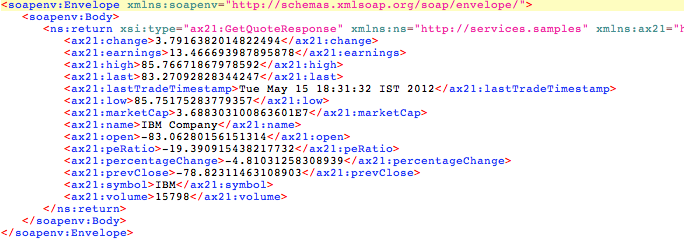This section explains, through an example scenario, how the Scatter-Gather EIP can be implemented using WSO2 ESB. The following topics are covered:
| Table of Contents |
|---|
...
- Download and install WSO2 ESB from http://wso2.com/products/enterprise-service-bus. For a list of prerequisites and step-by-step installation instructions, refer to Getting Started Installation Guide in the WSO2 ESB documentation.
- Start three sample Axis2 server instances on ports 9000, 9001, and 9002. For instructions, refer to the section Setting Upp the ESB Samples Setup - Starting Sample Back-End Servicesthe Axis2 server in the WSO2 ESB documentation.
...
Start the ESB server and log into its management console UI (https: //localhost:9443/carbon ). In the management console, navigate to Main Menu, click Services, then -> Services -> Add and then click Proxy Service. Next, copy and paste the following configuration, which helps you explore the example scenario, to a new Pass Through Proxy Service named ScatterGatherProxy. Anchor step3 step3
| Code Block | ||||
|---|---|---|---|---|
| ||||
<definitions xmlns="http://ws.apache.org/ns/synapse"> <proxy xmlns="http://ws.apache.org/ns/synapse" name="ScatterGatherProxy" transports="https http" startOnLoad="true" trace="disable"> <description/> <target> <inSequence> <clone> <target> <endpoint name="vendorA"> <address uri="http://localhost:9000/services/SimpleStockQuoteService/"/> </endpoint> </target> <target> <endpoint name="vendorB"> <address uri="http://localhost:9001/services/SimpleStockQuoteService/"/> </endpoint> </target> <target> <endpoint name="vendorC"> <address uri="http://localhost:9002/services/SimpleStockQuoteService/"/> </endpoint> </target> </clone> </inSequence> <outSequence> <log level="full"/> <aggregate> <completeCondition> <messageCount min="3"/> </completeCondition> <onComplete xmlns:m1="http://services.samples/xsd" xmlns:m0="http://services.samples" expression="//m0:return"> <enrich> <source xmlns:m1="http://services.samples/xsd" clone="true" xpath="//m0:return[not(preceding-sibling::m0:return/m1:last <= m1:last) and not(following-sibling::m0:return/m1:last < m1:last)]"/> <target type="body"/> </enrich> <send/> </onComplete> </aggregate> </outSequence> </target> </proxy> </definitions> |
Simulating the sample scenario
Use a SOAP client like SoapUI to send the following request to the
ScatterGatherProxyservice.Code Block language html/xml <soapenv:Envelope xmlns:soapenv="http://schemas.xmlsoap.org/soap/envelope/" xmlns:ser="http://services.samples"> <soapenv:Header/> <soapenv:Body> <ser:getSimpleQuote> <ser:symbol>foo</ser:symbol> </ser:getSimpleQuote> </soapenv:Body> </soapenv:Envelope>- Because the log mediator is enabled inside the outSequence, there will be three responses from the three vendors. The logs will be similar to the following:
- In SoapUI, you will get the response from the vendor providing the best quote as follows:
- Compare the logged response messages with the response received by the client to see that the
ScatterGatherProxyservice returns the best quote to the client.
How the implementation works
Let's investigate the elements of the ESB configuration in detail. The line numbers below are mapped with the ESB configuration shown above.
- clone [line 6 8 in ESB config] - In the
inSequenceof theScatterGatherProxyservice, we use the Clone mediator to make three copies of the request. Those requests are then forwarded to the three vendor services (SimpleStockeQuoteService). The responses to those three requests are received at theoutSequence. The Clone mediator is similar to the Splitter EIP. It clones the incoming request and passes the requests in parallel to several endpoints. - log [line 25 27 in ESB config] - All received responses are logged before the Aggregate mediator merges them.
- aggregate [line 26 28 in ESB config] - The Aggregate mediator aggregates response messages for requests made by the Iterate or Clone mediator. The completion condition specifies the minimum or maximum number of messages to be collected.
- onComplete [line 30 32 in ESB config] - When all messages are aggregated, the
onCompletesequence of the Aggregate mediator will run. This sequence is called once all responses are received or the specified completion condition is met. The responses are aggregated based on the value of thereturnelement in the response. - enrich [line 32 34 in ESB config] - The Enrich mediator is used to extract the response, which contains the best quote. The following XPath 1.0 expression is used for this purpose:
//m0:return[not(preceding-sibling::m0:return/m1:last <= m1:last) and not(following-sibling::m0:return/m1:last < m1:last)]
In essence, this expression instructs the ESB to pick the response that has the lowestlastvalue. (The XPath 2.0minfunction could reduce the complexity of the above expression, but XPath 1.0 is the current default supported by WSO2 ESB.) Once the proper response is found, we enrich the SOAP body with it and send that response back to the client.

